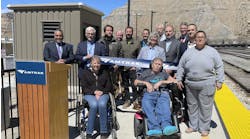Passengers catching a city bus in downtown Phoenix will find the new green features incorporated into the renovated Central Station Transit Center, 300 N. Central Ave., make for a more comfortable wait when the city of Phoenix facility reopens after a year of reconstruction on Monday, July 4, 2011.
Passengers will find respite under larger shade trees and swooping fabric canopies while enjoying the subdued desert palate punctuated by the brilliant color of the bike lockers, corner kiosks and night-time lighting. The transit center's sustainable features make for more cost-effective operations, those include: solar energy, light-emitting diode (LED) lights, low-flow plumbing fixtures, and programmable irrigation.
The city is pursuing certification for Leadership in Energy and Environmental Design (LEED) Existing Building Operation and Maintenance (EBOM) as one of the first refurbished buildings for the city.
Originally built in 1997, the 2-acre Central Station hosts 10 Valley Metro local bus routes, two express bus routes, and METRO light rail service within the property as well as houses Customer Service staff and Police Transit Bureau staff.
The $3.7 million design and reconstruction project was funded by a grant from the Federal Transit Administration through the American Recovery and Reinvestment Act. About 40 companies delivered goods and services for the project including Architectural Resource Team, Inc as the lead design consultant and Norquay Construction Inc. as the prime construction contractor.
Passenger Amenities
- More seating with benches and planter seatwalls
- Expanded shade areas using ramadas, fabric canopies, vertical screens, and large treesNew bike lockers and bike racks
- Air hose to inflate bike tires
- New lighting scheme including embedded lights in the walkways
- Information kiosk with bus schedulesUpgraded security system: more cameras with video recording and monitoring
- Chilled water fountain
Summary of Sustainable Features
- Solar Energy System uses photovoltaic laminate (thin-film) technology
- Existing concrete reused along with new pervious concrete in walkways
- Light-emitting diode (LED) lighting for increased longevity
- Irrigation system programmed to recognize weather conditions
- Shaded areas expanded with large trees, vertical screens, and canopies
- Bus stop and site signage have a modernized design using recycled steel
- Re-use of existing bus shelters
- Trash receptacles for recyclable items
Solar Energy System
- Photovoltaic laminate (thin-film) on rooftops throughout site
- Uses thin-film technology for photovoltaic cells
- Solar energy system output is 26 kilowatts (kW); enough to provide 35 percent of site's energy use
Lighting
- LED lighting throughout entire site including in signage
- LED lighting has average life of 50,000 hours versus 12,000 for fluorescent lights
- Embedded lights in walkways; some with an amber color
Signage
- Signage for bus stops and information uses recycled steel with a modernized design
- Signage includes a brief history of the Phoenix transit system
- 12 vertical shade screens imprinted with international transit system maps
- Lighted monument signs identifying Central Station at each corner
Shade
- Over 30 Large trees planted around the site
- 12 vertical shade screens imprinted with maps of famous transit systems
- 16 separate angled canopies of tensile fabric covering passenger waiting areas
- 9 ramadas covering passenger waiting areas
- Ramadas and canopies supported by Corten steel columns with a rusted effect
Landscaping and Walkways
- Desert shade trees and low-water use plants
- 8 quick-growing Pistache trees will create a large leafy canopy
- Structural soil mix engineered for heavier and healthier shade trees
- Walkways interwoven with reused concrete, new pervious concrete, and colored pavers
- Pervious concrete filters rainfall and wash water to plants and trees
Irrigation
- Drip irrigation system for the plants and trees
- Irrigation controller adjusts to weather conditionsMoisture sensor automatically modifies watering needs
- Polyvinyl Chloride (PVC) piping and fittings reduce water loss from leaks, pipe breaks, and rodent damage
Other
- Heating, Venting, and Air Conditioning (HVAC) split systems has a 15 Seasonal Energy Efficiency Ratio (SEER)
- Low-flow plumbing fixtures save 25 percent more water compared to the old system

